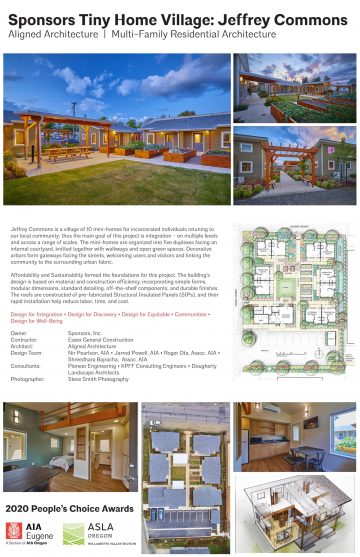1st place, Multifamily Residential Category
Colleague’s Choice Award
Featuring: Sponsors Tiny Home Village
This annual competition is organized by the American Insitute of Architects Eugene Chapter during the month of September, where local architects and landscape architects present their featured projects in various categories, and the citizens of Eugene cast their vote for the best project in each category. This project was also chosen as a winner in the colleague’s choice category in which AIA members in the community vote for their favorites of the entire project selection.
Project
Sponsor’s Tiny Home Village
Eugene, Oregon
Architect
Nir Pearlson Architect
Structural Engineer
Pioneer Engineering
General Contactor
Essex General Construction
Photos
Steve Smith Photography
CONCEPTS
Jeffrey Commons is a village of 10 mini-homes for incarcerated individuals returning to our local community; thus the main goal of this project is integration – on multiple levels and across a range of scales. The mini-homes are organized into five duplexes facing an internal courtyard, knitted together with walkways and open green spaces. Decorative arbors form gateways facing the streets, welcoming users and visitors and linking the community to the surrounding urban fabric.
- AFFORDABILITY
The building’s design is based on material and construction efficiency, incorporating simple forms, modular dimensions, standard detailing, off-the-shelf components, and durable finishes. The roofs are constructed of pre-fabricated Structural Insulated Panels (SIPs), and their rapid installation help reduces labor, time, and cost.
- SUSTAINABILITY
Sustainable strategies include highly insulated envelopes utilizing SIPS roof panels, and multiple windows providing ample daylight – both approaches resulting in reduced energy usage. Landscaped swales allow rainwater to percolate into the ground. The Common Building’s roof is designed to accommodate a solar PV array, and collect rainwater for irrigation. The most sustainable feature about the project is the homes’ size, which is “among the most important determinants of environmental impact” (Oregon Department of Environmental Quality, 2010). The small footprints and compact design will save resources during construction, and throughout the building’s lifecycle.
AIA CRITERIA
Equitable Communities
Community spaces include a lawn, ornamental landscaped areas including fruit trees, and vegetable garden beds. The Common Building includes a generous meeting room with a kitchen, a shared laundry room, and a secure bike storage room. Two sheltered gazebos and multiple benches throughout the community offer ample places to interact, and to relax year-round.
Well-Being
While the mini-homes are designed to be compact, simple, and minimal, each home contains all the spaces and amenities to support a healthy, independent, and dignified lifestyle. This includes a private entry porch, a living area, a sleeping area, a kitchen, built-in casework, and a bathroom with a shower. Multiple windows provide ample daylight and views while maintaining privacy.
Discovery
The project team applied experiences gained during the design and construction of Emerald Village Eugene, a community of 22 mini-homes for previously homeless persons. The designers maintain contact with the Owner group, are continue to learn lessons through operation and use, and carry these into future projects. A similar project is currently being designed in Woodland, CA, where 12 mini-homes will house previously homeless veterans.
View original article

